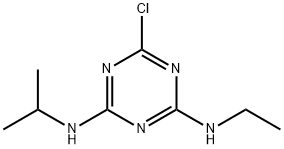1912-24-9

Product Name:
Atrazine
Formula:
C8H14ClN5
Synonyms:
2-Chloro-4-ethylamino-6-isopropylamino-1,3,5-triazine
Inquiry
CHEMICAL AND PHYSICAL PROPERTIES
| Physical Description | Atrazine is a white crystalline solid. Melting point 173-175 °C. Sinks in water. A selective herbicide used for season-long weed control in a variety of crops. |
|---|---|
| Color/Form | Colorless powder |
| Odor | Odorless |
| Boiling Point | Decomposes (NIOSH, 2023) |
| Melting Point | 347 to 351 °F (NTP, 1992) |
| Solubility | less than 1 mg/mL at 67.1 °F (NTP, 1992) |
| Density | 1.2 at 68 °F (est) (USCG, 1999) - Denser than water; will sink |
| Vapor Pressure | 3e-07 mmHg at 68 °F (NTP, 1992) |
| LogP | log Kow = 2.61 |
| Henry's Law Constant | Henry's Law constant = 2.6X10-9 atm-cu m/mol at 25 °C |
| Stability/Shelf Life | Stable under recommended storage conditions. |
| Decomposition | Hazardous decomposition products formed under fire conditions - Carbon oxides, nitrogen oxides (NOx), hydrogen chloride gas. |
| Corrosivity | Atrazine technical and formulated products are noncorrosive to equipment and metal surfaces. |
| Ionization Efficiency | Positive |
| Dissociation Constants | pKa = 1.60, very weak base |
| Collision Cross Section | 150.74 Ų [M+H]+ [CCS Type: DT, Method: stepped-field] |
| Kovats Retention Index | 1696 1708 1712 1729 1724 1711 1710 1726 1705 1726 1724.1 1720.6 1715.3 1696.8 1691 1724.2 1699 1699 1711 1718.5 1700 1700 1718.3 1714.6 |
| Other Experimental Properties | Conversion factors: 1 mg/L = 113.2 ppm; 1 ppm = 8.83 mg/cu m |
| Chemical Classes | Pesticides -> Herbicides, Triazine |
SAFETY INFORMATION
| Signal word | Warning |
|---|---|
| Pictogram(s) |
 Exclamation Mark Irritant GHS07  Health Hazard GHS08  Environment GHS09 |
| GHS Hazard Statements |
H317:Sensitisation, Skin H373:Specific target organ toxicity, repeated exposure H410:Hazardous to the aquatic environment, long-term hazard |
| Precautionary Statement Codes |
P260:Do not breathe dust/fume/gas/mist/vapours/spray. P272:Contaminated work clothing should not be allowed out of the workplace. P273:Avoid release to the environment. P280:Wear protective gloves/protective clothing/eye protection/face protection. P314:Get medical advice/attention if you feel unwell. P302+P352:IF ON SKIN: wash with plenty of soap and water. |
COMPUTED DESCRIPTORS
| Molecular Weight | 215.68 g/mol |
|---|---|
| XLogP3 | 2.6 |
| Hydrogen Bond Donor Count | 2 |
| Hydrogen Bond Acceptor Count | 5 |
| Rotatable Bond Count | 4 |
| Exact Mass | 215.0937732 g/mol |
| Monoisotopic Mass | 215.0937732 g/mol |
| Topological Polar Surface Area | 62.7 Ų |
| Heavy Atom Count | 14 |
| Formal Charge | 0 |
| Complexity | 166 |
| Isotope Atom Count | 0 |
| Defined Atom Stereocenter Count | 0 |
| Undefined Atom Stereocenter Count | 0 |
| Defined Bond Stereocenter Count | 0 |
| Undefined Bond Stereocenter Count | 0 |
| Covalently-Bonded Unit Count | 1 |
| Compound Is Canonicalized | Yes |
PRODUCT INTRODUCTION
description
Atrazine is an herbicide that does not occur naturally. Pure atrazine is an odorless, white powder that is not very volatile, reactive, or flammable and that will dissolve in water. Atrazine is used to kill weeds, primarily on farms, but has also been used on highway and railroad rights-of-way. The EPA now restricts how atrazine can be used and applied; only trained people are allowed to spray it.